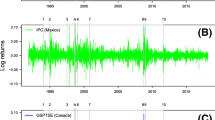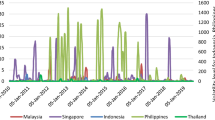Abstract
In this study, we investigate the connectedness between sharia stock index and three Islamic bond yields within a global perspective of the Gulf Cooperation Council Islamic financial markets. The main novelty of the present study is that we extend previous studies by performing three wavelet variants in bivariate and multivariate frameworks, namely the wavelet multiple correlation, the wavelet multiple cross correlation and wavelet cohesion. The findings point out a significant changing pattern in the dynamic linkage between sharia stocks and Islamic bond yields in the time-frequency domain. A strong positive association is evidenced in the short horizons and a negative linkage is branded for longer time-scales. Some resemblances are found for the wavelet cohesion corroborating the existence of potential portfolios’ diversification opportunities at lower frequencies. The multivariate wavelet cross correlation unveils that the intensity of the co-movement reaches its zenith at high frequencies. These results are not similar to the bivariate wavelet coherence but are coincident with the wavelet cohesion approach, which may be due to the difference in dimensionality of the wavelet approaches. The implications of this study will be useful for Islamic portfolio managers, international investors and market regulators in better encircling the best ways to adopt a proactive knowledge of Islamic financial markets behavior.




Similar content being viewed by others
Notes
Aloui et al. (2015a) discuss the main theoretical arguments to explain the association between sharia stocks and Islamic bonds.
We discuss these two arguments in Sect. 2.
The report is available on the link http://www.standardandpoors.com/spf/upload/Ratings_EMEA/IslamicFinanceOutlook_2014.pdf.
Chakrabarty et al. (2015) provide an excellent review of the migration of the wavelet methodology to finance.
Chakrabarty et al. (2015) establish a recent overview of the wavelet analysis and the investment horizon heterogeneous.
The data are available on the link: http://www.nasdaqdubaihsbcindices.com/Pages/indices.htm.
Readers can refer to the S&P Dow Jones Indices web link: http://us.spindices.com/indices/equity/sp-gcc-composite-shariah for more details.
We should note that the S&P GCC composite sharia stock index is a composite portfolio combining the sharia stocks in the GCC stock markets for the main common sectors with the following weights: Materials (32.1%), Financials (31.9%), Telecommunication Services (14.6%), Industrials (7.4%), Consumer Staples (5.7%), Consumer Discretionary (4.0%), Utilities (2.0%), Energy (1.4%) and Health Care (0.9%).
It is worthily noting that all the selected indexes are expressed in US dollar to avoid any bias created by foreign exchange rate fluctuations.
References
Aguiar-Conraria, L., Azevedo, N., & Soares, M. J. (2008). Using wavelets to decompose the time-frequency effects of monetary policy. Physica A: Statistical Mechanics and its Applications, 387, 2863–2878.
Akhtar, S. M., Jahromi, M., John, K., & Moise, C. E. (2012). Intensity of volatility linkages in Islamic and conventional markets. AFA 2012 Chicago meetings paper. Available at SSRN: http://ssrn.com/abstract=1782220. doi:10.2139/ssrn.1782220.
Aloui, C., Hammoudeh, S., & Hamida, H. B. (2015a). Co-movement between sharia stocks and sukuk in the GCC markets: a time frequency analysis. Journal of International Financial Markets, Institutions & Money, 34, 69–79.
Aloui, C., Hammoudeh, S., & Hamida, H. B. (2015b). Global factors driving structural changes in the co-movement between sharia stocks and sukuk in the Gulf Cooperation Council countries. North American Journal of Economics and Finance, 31, 311–329.
Aloui, C., Hammoudeh, S., & Hamida, H. B. (2015c). Price discovery and regime shift behavior in the relationship between sharia stocks and sukuk: A two-state Markov switching analysis. Pacific-Basin Finance Journal, 34, 121–135.
Aloui, C., & Hkiri, B. (2014). Co-movements of GCC emerging stock markets: new evidence from wavelet coherence analysis. Economic Modelling, 36, 421–431.
Aloui, C., Hkiri, B., & Nguyen, D. K. (2016). Real growth co-movements and business cycle synchronization in the GCC countries: Evidence from time-frequency analysis. Economic Modelling, 52, 322–331.
Cakir, S., & Raei, F. (2007). Sukuk and Eurobonds: Is there a difference in value at risk? International Monetary Fund Working Paper, WP/07/237.
Chakrabarty, A., De, A., Gunasekaran, A., & Dubey, R. (2015). Investment horizon heterogeneous and wavelet: Overview and further research directions. Physica A: Statistical Mechanics and its Applications, 429, 45–61.
Chen, W. D., & Li, H. C. (2016). Wavelet decomposition of heterogeneous investment horizon. Journal of Economics and Finance, 40, 714–743.
Cohen, J., Cohen, P., West, S., & Aitken, L. (2003). Applied multiple regression and correlation analysis (3rd Edn., 1). New Jersey: Lawrence Erlbaum Associates, Inc.
Croux, C., Forni, M., & Reichlin, L. (2001). A measure of co-movement for economic variables: Theory and empirics. Review of Economics and Statistics, 83, 232–241.
Dacorogna, M. M. R., Gen, U. Muller, Olsen, R. B., & Pictet, O. P. (2001). An introduction to high frequency finance. New York: Academic Press.
Dewandaru, G., Bacha, O. I., Masih, A. M., & Masih, R. (2015). Risk and return characteristics of Islamic equity indexes: A multi-time scale analysis. Journal of Multinational Financial Management, 29, 115–138.
Dewandaru, G., Rizvi, S. A., Masih, R., Masih, M., & Alhabshi, S. O. (2014). Stock market co-movements: Islamic versus conventional equity indices with multi-timescales analysis. Economic Systems, 38, 553–571.
Diebold, F. X., & Yilmaz, K. (2012). Better to give than to receive: Predictive directional measurement of volatility spillovers. International Journal of Forecasting, 23, 57–66.
El-Alaoui, A. O., Dewandaru, G., Al Azhar, S., & Masih, M. (2014). Linkages and co-movement between international stock market returns: Case of Dow Jones Islamic Dubai Financial Market index. Journal of International Financial Markets, Institutions and Money, 36, 53–70.
Fathurahman, H., & Fitriati, R. (2013). Comparative analysis of return on sukuk and conventional bonds. American Journal of Economics, 3, 159–163.
Fernandez-Macho, J. (2012). Wavelet multiple correlation and cross-correlation: A multiscale analysis of Eurozone stock markets. Physica A: Statistics Mechanics and its Applications, 391, 1097–1104.
Godlewski, C., Turk-Arsis, R., & Weill, L. (2013). Sukuk vs conventional bonds: A stock market perspective. Journal of Comparative Economics, 41, 745–761.
Goupillaud, P., Grossmann, P., & Morlet, J. (1984). Cycle-octave and related transforms in seismic signal analysis. Geoxploration, 23, 85–102.
Grinsted, A., Moore, J. C., & Jevrejeva, S. (2004). Application of the cross wavelet transform and wavelet coherence to geophysical time series. Nonlinear Processes in Geophysics, 11, 561–566.
Haile, F., & Pozo, S. (2008). Currency crisis contagion and the identification of transmission channels. International Review of Economics and Finance, 17, 572–588.
Islamic Finance Outlook report. (2014). www.standardandpoors.com/spf/.../IslamicFinanceOutlook_2014.pdf.
In, F., Kim, S., & Gencay, R. (2011). Investment horizon effect on asset allocation between value and growth strategies. Economic Modelling, 28, 1489–1497.
Kim, S., & In, F. (2007). On the relationship between changes in stock prices and bond yields in the G7 countries: Wavelet analysis. Journal of International Financial Markets, Institutions and Money, 17, 167–179.
Kim, S., & In, F. (2010). Portfolio allocation and the investment horizon: A multi-scaling approach. Quantitative Finance, 10, 443–453.
Ljung, G. M., & Box, G. E. P. (1978). On a measure of a lack of fit in time series models. Biometrica, 65, 297–303.
Maghyereh, A. I., & Awartani, B. (2016). Dynamic transmissions between Sukuk and bond markets. Research in International Business and Finance, 38, 246–261.
Mensi, W., Hammoudeh, S., Reboredo, J. C., & Nguyen, D. K. (2015). Are Sharia stocks, gold and US Treasury hedges and/or safe havens for the oil-based GCC markets? Emerging Markets Review, 24, 101–121.
Miller, N., Challoner, J., & Atta Aziza, J. (2007). UK welcomes the sukuk. International Financial Law Review, 26, 24–25.
Moya-Martinez, P., Ferrer-Lape, R., Francisco, N., & Sotos, E. (2015). Interest rate changes and stock returns in Spain: A wavelet analysis. Business Research Quarterly, 18, 95–110.
Naifar, N. (2016). Modeling dependence structure between stock market volatility and sukuk yields: A nonlinear study in the case of Saudi Arabia. Borsa Istanbul Review, 16, 157–166.
Naifar, N., Hammoudeh, S., & Al-Dohaiman, M. S. (2016). Dependence structure between sukuk (Islamic bonds) and stock market conditions: An empirical analysis with Archimedean copulas. Journal of International Financial Markets, Institutions and Money, 44, 148–165.
Rizvi, S. A., Arshad, S., & Alam, N. (2015). Crisis and contagion in Asia Pacific Islamic v/s conventional markets. Pacific Basin Finance Journal, 34, 315–326.
Rua, A. (2010). Measuring co-movement in the time-frequency space. Journal of Macroeconomics, 32, 685–691.
Rua, A. (2013). Worldwide synchronization since the nineteenth century: A wavelet-based view. Applied Economic Letters, 20, 773–776.
Rua, A., & Lopes, A. S. (2015). Cohesion within the euro area and the US: A wavelet-based view. OECD Journal: Journal of Business Cycle Measurement and Analysis, 2014(2), 63–76. doi:10.1787/jbcma-2014-5js1j15792zp.
Rua, A., & Nunes, L. C. (2009). International co-movement of stock market returns: A wavelet analysis. Journal of Empirical Finance, 16, 632–639.
Thuronyi, V. (2007). A level tax playing field in Islamic finance. Washington, D.C.: Paper presented at the International Monetary Fund Spring Meeting.
Torrence, C., & Compo, G. P. (1998). A practical guide to wavelet analysis. Bulletin of the American Meteorological Society, 79, 61–78.
Torrence, C., & Webster, P. J. (1999). Inter-decadal changes in the ENSO-monsoon system. Journal of Climate, 12, 2679–2690.
Wilson, R. (2008). Innovation in structuring of sukuk securities. Humanomics, 24, 170–181.
Yang, Lu, & Hamori, S. (2015). Interdependence between the bond markets of CEEC-3 and Germany: A wavelet coherence analysis. North American Journal of Economics and Finance, 32, 124–138.
Acknowledgements
C. Aloui and H. B. Hamida would like to extend their sincere appreciations to the Deanship of Scientific Research at King Saud University for its funding of this research through the Research Group Project [RGP-211].
Author information
Authors and Affiliations
Corresponding author
Rights and permissions
About this article
Cite this article
Aloui, C., Jammazi, R. & Hamida, H.B. Multivariate Co-movement Between Islamic Stock and Bond Markets Among the GCC: A Wavelet-Based View. Comput Econ 52, 603–626 (2018). https://doi.org/10.1007/s10614-017-9703-7
Accepted:
Published:
Issue Date:
DOI: https://doi.org/10.1007/s10614-017-9703-7




